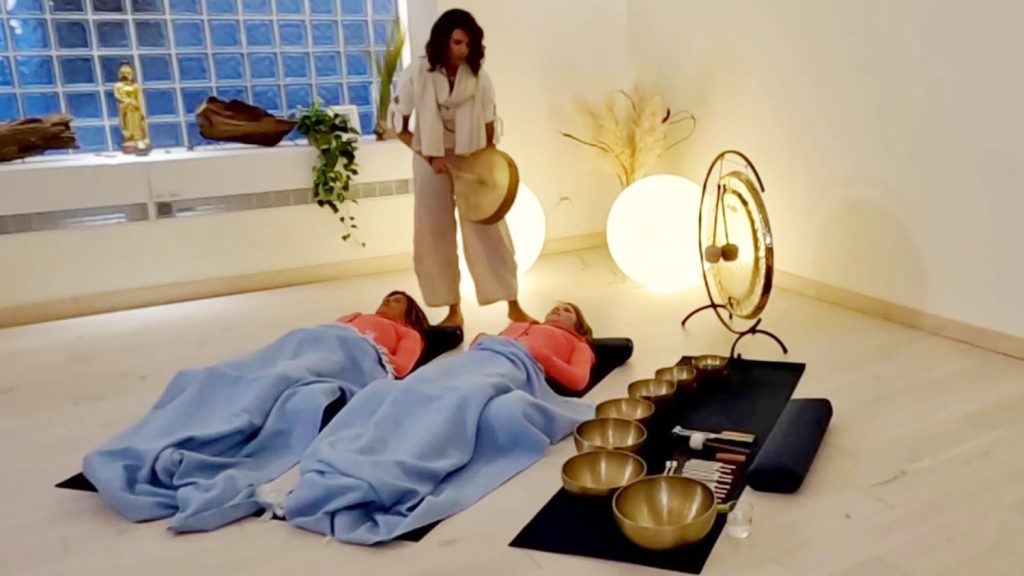Musical Bath: Integrating Soothing Sounds in Meditation to Enhance Focus

Experience Serenity Through Sound
In today’s fast-paced world, achieving mental clarity can feel like an uphill battle. Integrating soothing sounds into meditation practices provides a pathway to unparalleled focus and tranquility. This innovative approach is quickly gaining traction in wellness circles, especially in bustling environments like Nigeria, where the daily hustle can often lead to overwhelming stress and anxiety.
Why Embrace a Musical Bath?
Embracing a musical bath during meditation offers numerous benefits. The integration of sound into mindfulness practices can transform how one approaches these moments of introspection.
- Enhances focus: Soothing sounds create an atmosphere conducive to deep concentration. For instance, doctors and researchers have noted that individuals who listen to calming music while studying or working tend to retain information better compared to those who work in silence or with distracting noise.
- Promotes relaxation: Gentle melodies can reduce stress levels, allowing for a more profound meditative experience. Studies have shown that listening to soft instrumental music has physiological benefits, such as lowering heart rates and reducing blood pressure.
- Cultivates mindfulness: Music helps anchor the mind, keeping it from wandering during meditation. The rhythm and flow of melodic tunes can provide a framework for breathing exercises, making it easier for beginners to maintain focus.
Elements of Soothing Sounds
Different sounds can be utilized to elevate your meditation practice, creating a multi-sensory experience that nurtures the spirit and calms the mind. Here are some prevalent elements to consider:
- Nature sounds: The gentle rustle of leaves, chirping of birds, or flowing water can transport you to a serene environment. In Nigeria, where nature is vibrant, recordings of local wildlife can evoke a profound sense of peace and connection to the earth.
- Instrumental music: Soft piano or harp melodies engage the senses without being distracting. Local musicians have increasingly created soothing tracks that infuse traditional African elements into contemporary compositions, enhancing the meditative experience.
- Tibetan singing bowls: The resonation can foster a deep sense of connection and calmness. Often utilized in yoga studios, these bowls are gaining popularity in Nigeria, as practitioners seek more holistic approaches to health.
As the concept of a musical bath unfolds, it encourages us to rethink how we experience meditation. The marriage of sound and serenity not only enhances personal well-being but also stimulates social conversations around mental health and wellness in various communities. By combining sound and tranquility, individuals can unlock new levels of focus and peace, making this an invaluable practice in today’s demanding society. More Nigerians are exploring these techniques to combat urban stressors, promoting a culture of mindfulness that aims to improve the overall quality of life.
YOU MAY ALSO LIKE: Read read another article

Creating a Harmonious Atmosphere for Meditation
To harness the remarkable benefits of a musical bath, it is essential to create an atmosphere that aligns with the calming effects of sound. The incorporation of soothing sounds into your meditation rituals can turn an ordinary session into a profoundly enriching experience. Considerations for setting up this harmonious environment can involve both the physical space and the auditory stimuli.
Steps to Cultivate the Perfect Soundscape
Here are several key steps to ensure that your meditation practice is accompanied by the right soundscape, allowing you to dive deeper into focus and mindfulness:
- Choose the right location: Select a quiet area where noise pollution is minimized. Ideally, it should be a place where you feel safe and comfortable, allowing you to immerse fully in your meditative state.
- Select appropriate audio: Curate a playlist of soothing sounds or instrumental music that resonates with you. You might want to explore local Nigerian artists who incorporate traditional sounds, as their music often ties back to rich cultural heritage while promoting relaxation.
- Adjust volume and clarity: Ensure that the sound is neither too loud nor too soft. The goal is to create a backdrop that gently envelops you without drawing your attention away. High-quality speakers or headphones can significantly enhance the clarity of the audio experience.
- Incorporate rhythmic elements: Sounds with a natural rhythm can be particularly beneficial. For example, drum patterns or gentle percussion can help guide your breath and enhance the meditative experience. Explore local drumming styles that may add a unique flavor to your practice.
- Experiment with duration: Identify how long you would like to immerse yourself in the musical bath. Some practitioners find that longer sessions open deeper channels of focus, while others may prefer shorter bursts to refresh their minds throughout the day.
By meticulously curating your auditory environment, you not only heighten the meditative practice but also create a sacred space that encourages a deeper connection to oneself. Many studies have underscored the significance of sound in cognitive processes, indicating that engaging with music can help to reinforce memory retention and enhance overall cognitive function.
As you explore integrating soothing sounds into meditation, think about how sounds can influence emotional states and cognitive clarity. In today’s world, where distractions are abundant, establishing a routine around musical baths can be a powerful tool for achieving greater mental acuity. Moreover, given the unique blend of cultures and sounds present in Nigeria, you have the opportunity to create a meditation practice that is not only personal but also reflective of your rich heritage. It is through this integration of tradition and modern mindfulness that practitioners can unlock a transformative experience.
Discovering the Benefits of Musical Baths
Integrating soothing sounds into meditation practices can significantly enhance focus and overall mental well-being. The concept of a “Musical Bath” combines elements of sound therapy with traditional meditation techniques, creating an immersive auditory experience. By enveloping oneself in gentle melodies and ambient sounds, individuals often find it easier to transcend everyday distractions and deepen their meditative state. Research indicates that specific frequencies can influence brain waves, leading to heightened states of relaxation and clarity. This auditory stimulation not only soothes the mind but also fosters a conducive environment for mindfulness practices. Practitioners report improved concentration, reduced anxiety levels, and an enhanced ability to remain present during meditation sessions.Below is a detailed table that outlines some of the key advantages of this innovative approach to meditation through the perspective of “Musical Bath.”
| Category | Benefits |
|---|---|
| Enhanced Relaxation | The soothing sounds lower stress hormones, promoting a peaceful state conducive to meditation. |
| Improved Concentration | Targeted sound frequencies can help listeners maintain focus, allowing for deeper meditation. |
By engaging in a Musical Bath, individuals can harness the power of sound to elevate their meditation practices. Further exploration into different soundscapes used in these sessions may reveal a plethora of techniques that can lead to a more enriched experience.
YOU MAY ALSO LIKE: Read read another article
The Science Behind Sound and Meditation
Understanding how sound impacts the brain can significantly enhance the practice of meditation. Several studies have explored the neuroscience of music, revealing that sounds can influence emotional well-being, reduce anxiety, and heighten concentration. Engaging with soothing sounds during meditation activates specific brain pathways that promote a state of calm and focus, serving as a cognitive anchor that centers you in the present moment.
The Effects of Sound Waves on Brain Activity
Research indicates that different sound frequencies can lead to varied responses in the human brain. When you listen to calming music or nature sounds, your brain may produce alpha waves, which are associated with relaxation and creativity. These frequencies help prevent your mind from wandering, providing a foundation for deeper meditation and heightened awareness. A study published in the “Journal of Alternative and Complementary Medicine” noted that participants exposed to meditative music experienced a reduction in anxiety levels and an increase in overall satisfaction with their meditation practice.
Incorporating Traditional Nigerian Sounds
In Nigeria, the use of traditional music as a therapeutic tool has deep cultural roots. Instruments like the talking drum, shekere, and kalimba can be seamlessly integrated into your musical bath for an authentic experience that not only promotes relaxation but also connects you to your cultural heritage. The rhythmic and melodic qualities of these instruments can support your meditation journey, grounding you while encouraging a greater sense of community and belonging.
Personalizing Your Musical Bath Experience
The beauty of a musical bath lies in its adaptability. Personalizing your auditory landscape means exploring various genres and styles to create a unique experience. For instance, some may find that instrumental Afrobeat fusion enhances their focus, while others might resonate more with traditional folk melodies or the gentle sounds of nature found in Nigerian bush environments. By alternating between different types of audio, you can find what best aids your mental clarity and depth of meditation.
Benefits of Immersive Auditory Experiences
Participating in a musical bath not only enriches your meditation practice but can also yield numerous psychological benefits. Regular engagement with soothing sounds has been linked to improved cognitive function, showcasing potential benefits for students and professionals alike. In a bustling environment like Nigeria’s urban centers, where individuals frequently face stressors, these auditory experiences provide an escape, enabling listeners to concentrate better and immerse themselves in their tasks.
Furthermore, the rhythmic aspect of musical baths can tie into physical movement practices like yoga, enhancing the overall experience. It allows practitioners to develop a synchronized relationship with their movements and the changing sounds around them, fostering a greater sense of unity between the body and mind.
As the trend of integrating soothing sounds into meditation continues to rise, communities across Nigeria are beginning to recognize the profound potential of these practices. Workshops and group sessions focused on musical baths are becoming increasingly popular, offering spaces for individuals to explore sound while forging connections with others on similar journeys toward mindfulness. This collective experience underscores the significance of music and sound as not only personal but also communal healing tools.
CHECK OUT: Click here to explore more
Conclusion
Incorporating soothing sounds into meditation practices, often referred to as a musical bath, presents a dynamic approach to enhancing focus and mental clarity. By understanding how sound interacts with our brain and emotional states, practitioners in Nigeria and beyond can utilize auditory experiences to transform their meditation sessions into profound journeys of self-discovery and relaxation. The rhythmic melodies of traditional instruments, combined with modern soundscapes, provide a rich tapestry that resonates within our cultural and emotional frameworks, making meditation both a personal and a communal experience.
This exploration reveals more than mere auditory pleasure; it underscores the psychological benefits that can be derived from regular engagement with musical baths. As research continues to illuminate the connections between sound, brain activity, and mindfulness, individuals are encouraged to explore diverse genres and blend traditional Nigerian sounds with contemporary elements to create a personalized meditation atmosphere. Such a tailored approach not only fosters deeper focus but also celebrates our unique cultural heritage.
As communities continue to recognize the value of these practices, the rise of workshops and collective sessions emphasizing musical baths illustrates a growing commitment to mental wellness. Therefore, whether it is through the calming strums of the kalimba or the vibrant beats of the talking drum, integrating soothing sounds into meditation is not just a trend but a powerful tool for enhancing focus and enriching life in today’s fast-paced world. Engaging in this rhythmic exploration may just be the key to unlocking a serene yet vibrant mind.



